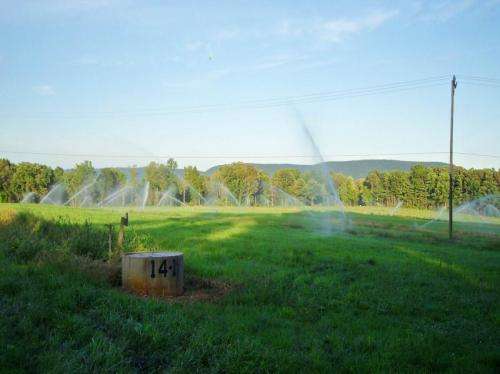Soils could keep contaminants in wastewater from reaching groundwater, streams

With endocrine-disrupting compounds affecting fish populations in rivers as close as Pennsylvania's Susquehanna and as far away as Israel's Jordan, a new research study shows that soils can filter out and break down at least some of these emerging contaminants. The results suggest that water pollution can be diminished by spraying treated wastewater on land rather than discharging it directly into streams, according to researchers in Penn State's College of Agricultural Sciences.
Using Penn State's 600-acre "Living Filter"—a wastewater reuse system less than a mile from the University Park campus—as a laboratory, researchers tested soil samples for the presence and accumulation of three estrogens. For almost three decades, more than 500 million gallons of treated wastewater from the campus has been sprayed annually from irrigation pipes onto this site, which is composed of cropland, grassland and forest.
To understand how endocrine-disrupting compounds behave in the soil, researchers extracted samples and analyzed for two natural estrogens, 17-beta-estradiol and estrone—hormones naturally produced by humans and animals, such as dairy cattle—and one synthetic estrogen, 17-alpha-ethynylestradiol—a compound in birth-control pills.
Led by Emily Woodward, doctoral candidate in Soil Science working with Jack Watson, professor of soil science, researchers took samples from different depths within the vadose zone—the soil layers between the surface and the groundwater table. Their goal was to determine whether chemicals in the wastewater irrigation were accumulating in those strata and not reaching groundwater.
The researchers compared soil estrogen concentrations for two independent variables—type of land cover and sampling time. They sampled from cropped and forested land at two days and three weeks after a 12-hour effluent-irrigation event. They also sampled a non-irrigated control site to provide natural background data.
"We found that soil samples from the Living Filter site contained higher concentrations of estrone and 17-beta-estradiol compared to samples taken from the non-irrigated site. But concentrations of 17-alpha-ethynylestradiol—the synthetic birth-control estrogen—were generally the same at both irrigated and non-irrigated sites," Woodward said.

"Within the Living Filter, accumulation of endocrine-disrupting compounds in the soil depended on land use. Forested soils accumulated higher levels of the compounds compared to the soil in areas being used for agriculture."
One important difference between soils in the croplands and forests of the Living Filter is the amount and quality of organic carbon present, Woodward explained. "If you have a lot of organic carbon in the soil, then the estrogen compounds are going to bind to the carbon and not move as rapidly through the soil," she said.
"Forested soils had almost three times the amount of organic carbon as the agricultural soils, which might explain the increased accumulation of endocrine-disrupting compounds in these soils."
The research, which was published in the Journal of Environmental Quality, is important because it suggests a way to begin dealing with the worldwide problem of endocrine-disrupting compounds finding their way into streams and other drinking-water sources.
"These emerging contaminants could be a potential issue, especially in arid regions where there is consideration of using treated wastewater to irrigate crops or recharge aquifers," Woodward said. "However, this research shows—at least in the case of the 17-alpha birth-control estrogen—that some endocrine-disrupting compounds are not accumulating in the soil but are breaking down, which is a good thing. If future studies generate similar results, perhaps we can continue to use treated wastewater as a resource in areas where we need extra water, as well as provide a means of reducing exposure of fish to estrogens from wastewater discharged to streams, the common disposal method."

Scientists believe that male fish coming into contact with estrogens from wastewater effluent or agricultural runoff synthesize a protein that female fish use to produce yolks. This "feminization response," which occurs at low estrogen concentrations, causes hermaphroditism in male fish, and it can destroy the fish population. Black bass with egg cells in their testes have been found in waters around the world, with one in five male bass affected in rivers such as the Susquehanna and Potomac.
The exact ramifications of emerging contaminants on human health remain unclear. "But I think we all can agree that we don't want to be exposed to hormones through our environment and drinking water," Woodward said. "Studies also have shown that an increase in environmental estrogen exposure can affect endocrine and reproductive processes in vertebrates—including humans."
The next step in the research, Woodward noted, will be to measure the levels of estrogens in groundwater wells near the Living Filter site. Those measurements will confirm whether the soil is filtering the endocrine-disrupting compounds and preventing groundwater contamination. No matter the result, science holds the key to solving the problem posed by emerging contaminants, she said.
"I don't think every sewage treatment plant is going to be able to spray wastewater onto a managed landscape, but this is one method that could be used for removal of estrogen-like compounds. We need new technology to remediate this issue, especially for the big-city plants that are discharging directly into rivers. The question is, can we develop a process that can eliminate the endocrine-disrupting compounds in the effluent that reaches the rivers?"
Journal information: Journal of Environmental Quality
Provided by Pennsylvania State University

















